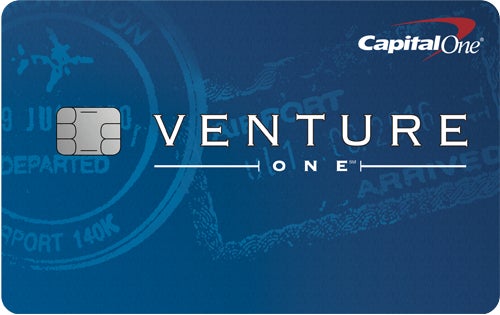Summary
At first glance, it may be difficult to see the difference between the Venture and VentureOne cards. Read on to see why the Venture card – even with its annual fee – may be the better choice for you.
The content on this page is accurate as of the posting date; however, some of our partner offers may have expired. Please review our list of best credit cards, or use our CardMatch™ tool to find cards matched to your needs.
The Capital One Venture Rewards Credit Card and the Capital One VentureOne Rewards Credit Card look so much alike – with similar-sounding names and similar blue exteriors – you may wonder how they differ from each other.
Essentially, both cards offer the same redemption options, but the Venture Card is the more premium version, with a larger sign-up bonus, a higher 2X miles earning rate and an annual fee of $95.
Our math shows that for most cardholders – those who spend at least $12,667 per year – the Venture Card more than makes up for its annual fee.
Capital One Venture vs. VentureOne
| Card |  Capital One VentureOne Rewards Credit Card |  Capital One Venture Rewards Credit Card |
|---|---|---|
| Rewards rate |
|
|
| Sign-up bonus | 20,000 miles if you spend $500 in first 3 months | 75,000 bonus miles when you spend $4,000 in the first 3 months |
| Annual fee | $0 | $95 |
| Average rewards earnings in the first year ($15,900 spend, including sign-up bonus) | $423 | $1,078 |
Earning rewards
When it comes down to it, the Capital One Venture Card is simply a higher-earning rewards card than the Capital One VentureOne. Both cards earn 5 miles per dollar spent on hotels and rental cards booked through Capital One Travel, but their key difference is that the Venture Card earns an unlimited 2 miles per dollar on all other purchases.
On the other hand, the VentureOne brings in 1.25 miles per dollar on general purchases. That’s nothing to scoff at when compared with other rewards cards that tend to bring in 1 mile per dollar, but it’s still lower than the Venture Card’s attractive 2 miles.
Sign-up bonus
The Venture Card’s sign-up bonus is much larger than the VentureOne’s, making it the clear choice for value in the first year – even considering the $95 annual fee. If you spend $4,000 within the first three months, you’ll earn a 75,000-mile bonus, which amounts to $750 in rewards.
However, if you don’t consider yourself a big spender that $4,000 spend goal may be difficult to achieve. In that case, the VentureOne Card’s sign-up bonus of 20,000 miles after you spend $500 in the first three months is still impressive for a card with no annual fee. The VentureOne still garners a good number of rewards for more modest spenders.
For those who absolutely must have the Venture Card after hearing about its hefty sign-up bonus but don’t know how to reach $4,000, consider using your card on big bills such as car insurance, utilities or the like.
Annual fee
Of course, the Venture Card’s impressive rewards come with a price – an annual fee of $95. But don’t let that deter you. As long as you spend at least $12,667 each year (more on that below), the fee is worth it.
Our math in the table below shows it doesn’t take an exceptional amount of spending to see the advantage of the Capital One Venture Card. You only need to spend $12,667 per year ($1,056 per month) for the rewards earnings on the Venture Card (minus its annual fee) to outweigh the earnings on the VentureOne card.
While that’s not pocket change, it’s a pretty manageable amount for most families who intend to put all their spending on one card.
Rewards value for $12,667 annual spend ($1,056 per month)
| Capital One VentureOne Card | Capital One Venture Card |
|---|---|
| 1.25% x $12,667 = $158 | (2% x $12,667) – $95 annual fee = $158 |
However, if $1,056 per month is a bit out of your range (perfectly understandable for single earners), the Capital One VentureOne card still provides great rewards.
Other perks
Both cards have excellent benefits, such as unlimited rewards, no minimum mile requirement to redeem for travel and no foreign transaction fee (essential when traveling abroad). They also both allow you to transfer miles to Capital One’s more than 15 travel partners.
On its own, the Capital One VentureOne comes with a few nice perks such as travel accident insurance, extended warranty on certain eligible items and more.
As for the Venture Rewards Card, it offers a few luxury travel benefits such as two free visits per year to the Capital One Lounge, up to $100 credit for Global Entry or TSA PreCheck and Hertz Five Star status.
Redemption value
Capital One provides several redemption options, but the best option by far is redeeming through Capital One Travel at a rate of 1 cent per mile. As for the other redemption options: If you choose to redeem for gift cards, a statement credit or check, the value of a mile dips to 0.8 cents or 0.5 cents.
That limits the value of Capital One miles since you’re encouraged to spend mostly on travel purchases with Capital One Travel. At least the Venture Card slightly makes up for this disadvantage by earning 2X miles on general purchases, but the redemption value does hurt the worth of the VentureOne Card.
With a cash back card, you can get the same redemption value for your miles with more flexibility since you can use cash back any way you please, not just for travel redemptions. (Note: The VentureOne Card offers cash back as a redemption option but at a lower value of 0.5 cents per mile.)
As it happens, there are many cash back cards on the market that charge no annual fee and offer rewards rates of 1.5% and higher. In other words, a plethora of cards offers a higher rewards rate and more flexibility than the VentureOne Card.
Capital One Venture: Best for first-year rewards
The Capital One Venture Card offers simplicity with its flat 2 miles per dollar earning rate on every purchase and some flexibility with its redemption options. Top it off with an industry-leading sign-up bonus, and it becomes a card that’s difficult to beat, even with its annual fee.
However, as we’ve mentioned, you should spend $1,056 per month or more to experience the advantage of this card over the VentureOne. For frequent travelers and families, this is a great card to use for all or most of your purchases.
Capital One VentureOne: Best for low-budget spenders
Of course, not everyone’s up for paying a $95 fee. If you don’t have the funds to manage more than $1,000 per month of spend on a credit card or you’re not certain you’ll travel frequently enough to redeem your rewards on a regular basis, the VentureOne Card is a very good no-annual-fee alternative. It’s 20,000-mile sign-up bonus is nothing to laugh at, either, and its rewards structure will still earn you a decent number of miles if you use the card for most of your purchases.
Bottom line
Overall, the Venture and VentureOne cards are both great, simple, flat-rate travel cards that are a good choice for cardholders who would rather use one card for every purchase. But if you’re a heavy spender who doesn’t mind paying an annual fee, you stand to squeeze more value out of the Venture Card – thanks to its double rewards rate on purchases and its generous sign-up bonus.
Editorial Disclaimer
The editorial content on this page is based solely on the objective assessment of our writers and is not driven by advertising dollars. It has not been provided or commissioned by the credit card issuers. However, we may receive compensation when you click on links to products from our partners.





